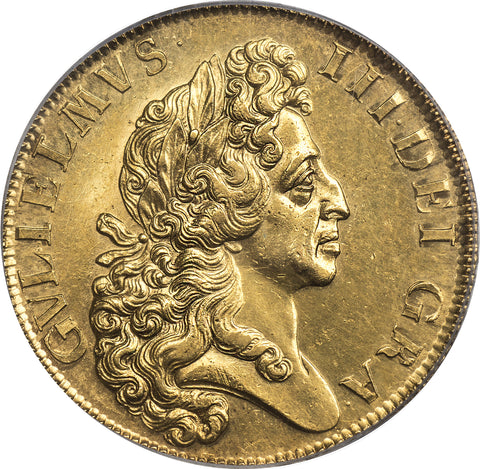William III Gold "Fine Work" 5 Guineas 1701 PCGS MS62
William III Gold "Fine Work" 5 Guineas 1701, S3456, PCGS MS62, a gorgeous and very choice example of this 1-year type with the deeply engraved portrait in high relief, and here it is about as fine as can be, the reverse crowned cruciform shield equally impressive and well detailed, legends huge and bold too, dies beautifully centred, rims nearly perfect, fields showing only tiny abrasions, luster intense but slightly disturbed (hence the "62" grade), and all enhanced by well-set, golden toning. Only occasionally does an exceptional example of this exotic style come onto the market. A classic in gold, literally a coiner's masterpiece!
On the death of Queen Mary at the very end of December 1694, King William ruled alone for the first time. Silver coinage and small gold in his name commenced in 1695, but his first large gold pieces were minted in 1699. While much of the energy of the Royal Mint’s workers and administrators was devoted to the Great Recoinage of the silver, and the temporary establishment and furnishing of branch mints around the kingdom during this reign, no little attention was given to the standard gold which was the backbone of the nation’s financial strength. The need was indeed great to recall worn, clipped, and difficult-to-value older silver. Tons of it came into these smelting and minting facilities beginning late in 1696 and concluding in 1698 but the year 1697 saw the heaviest exchange. By 1699, almost all old silver in circulation had been exchanged, and melted, and the country saw a deluge of bright, freshly minted sixpence, shilling and halfcrown coins. At just the same time, Isaac Newton’s work at the Mint changed from that of Warden to Master-worker, or Mint-master. As a man of science, Newton brought both more control and a more scientific approach to the operations of the Mint. Beginning in 1699, Newton watched and weighed the Mint’s suppliers of gold especially and soon learned that a few grains of gold was a standard variance for the Mint that was being used to certain merchants’ advantage when they returned slightly heavy coins to the Mint for a profit. Newton began testing all newly minted gold to assure that it would be of precise weight and fineness, and also required exact measures of all worn and foreign gold brought to the Mint in exchange for new money. By treating foreign money as mere bullion rather than accepting it at a set exchange value, he caused an influx of worn gold to come into the Mint during 1701-02, most of which was coined into guinea denominations. In this way he caused British gold coins to be consistently pure and of precise value. The Royal Mint had been modernized. The first 5 guineas issued for William III varied greatly on the reverse from the coins issued by him with Mary, reverting to the cruciform style seen on the gold of Charles II. The king’s portrait was shallowly engraved. But Newton had not finished making changes at the Mint: next he attempted to complete the transition begun during the Renaissance, of departing from the shallow style of portraiture of the monarch to one that suggested lifelike qualities. In 1701 he caused a portrait to be engraved that would not be equalled until the 1760s’ patterns of George III. As Mint-master, Newton’s finest artistic achievement is, without argument, the deeply engraved 5 guineas of 1701, now known as the ‘fine work’ issue, and it has become one of the classics of British numismatics. Its conception has never been documented in detail but its appearance arose from another propitious change at the Royal Mint. For about a third of a century, the job of engraving coin dies had been dominated by the Roettiers family of Brussels. The elder of the family, John, had found favour with Charles II when Thomas Simon, as the former engraver of Cromwell’s coins and seals, saw his tenure decline. John and his brothers, Joseph and Philip, in the words of Challis, exercised the ‘controlling influence over English engraving’ during the last years of the seventeenth century (New History of the Royal Mint, page 363) along with John’s sons James and Norbert, who under his guidance completed much of the die-work during the reigns of James II and of William & Mary and then of William alone. Slowly, the Roettiers faded from the scene: John the master engraver suffered injury, Joseph moved to the Paris Mint, Philip returned to Brussels to work, Norbert left for France in 1695, and James came under suspicion of counterfeiting in 1697 and was dismissed. No one capable was left, save for a young assistant named James Bull. Then suddenly a German jeweller from Dresden named John Croker was brought to the Mint. He soon tired of re-engraving dies made by the Roettiers during 1698-99, and he produced the now-famous ‘flaming hair’ shillings. Newton and others took note and promoted him. His mark on English coinage and medals became indelible, and among his medals may be found exquisite images in high relief, but his greatest achievement was certainly the ‘fine work’ engraving of the king’s portrait used in only one year, 1701, on the gold 2 guineas and 5 guineas. These are the ultimate numismatic images of the reign, magnificent money created three centuries ago and rarely equalled as works of art in all the years that have followed.


